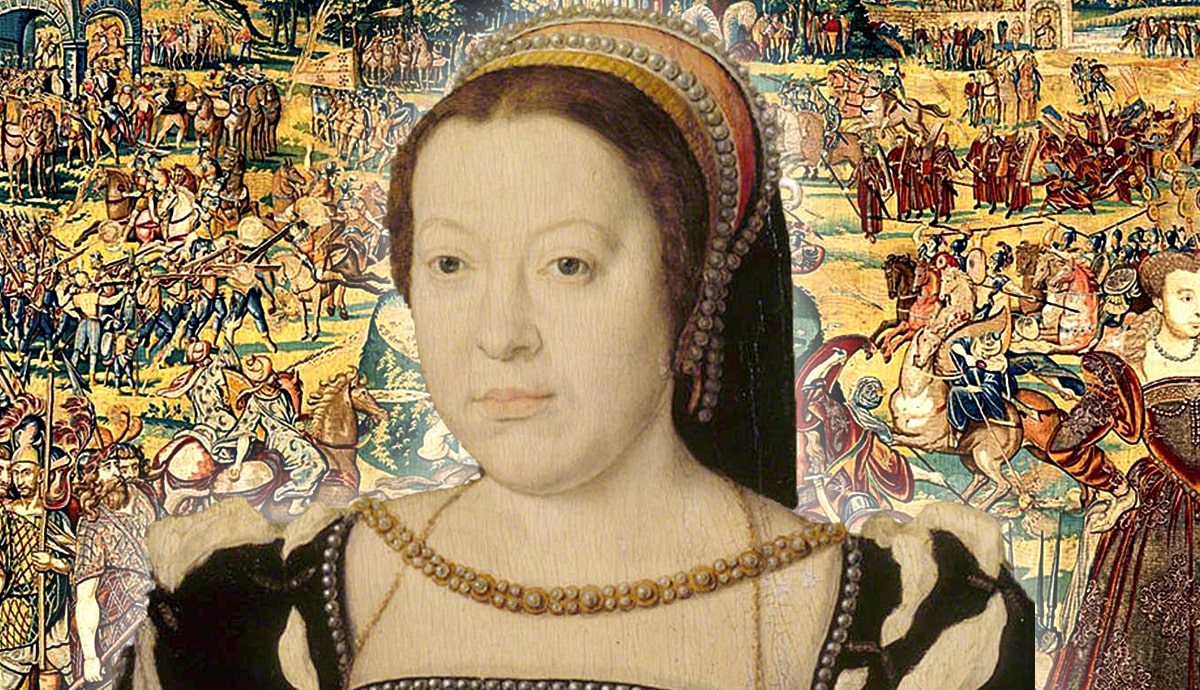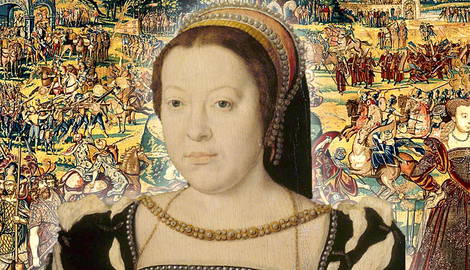
One of many divisive figures in history, Catherine de Medici of the Medici family, has been equally vilified and glorified. Born into Florentine nobility, Catherine was able to secure status and power through marriage and her children. During her reign – as well as her position as the queen mother – she also launched a thirty-year program of artistic patronage, spanning from fine art to large architectural projects. Some take a less positive stance on Catherine de Medici and her reign, highlighting her warmongering and supposed involvement in infamous massacres. There is no doubt, however, that she was the most powerful woman in 16th-century Europe with her influence extending well beyond the remit of a noblewoman or queen of her day.
Catherine de Medici of the Medici Family: Early Life

Catherine de Medici, as her name would suggest, was born into the illustrious Medici family in Florence. She was the daughter of Lorenzo di Piero de Medici, the duke of Urbino, and Madeleine de la Tour d’Auvergne, from the French Bourbon dynasty. Their marriage was a strategic one, negotiated by Francis I of France and Pope Leo X as part of an alliance. It is important to note that Leo X himself was a Medici, born Giovanni di Lorenzo de Medici, the son of Lorenzo the Magnificent. It was Lorenzo who first envisaged power for the Medici family that would extend beyond Florence. With the papacy in sight, Lorenzo successfully campaigned to have Giovanni named cardinal at just thirteen.
Like father like son, Leo X had big plans. The marriage (and alliance) between Lorenzo di Piero and Madeleine de la Tour was a boon for the Medici family, as they had experienced a period of misfortune, with public sentiment towards them at an all-time low. Though the Medici family would make incredible headway in the coming decades, establishing themselves as being of considerable repute, Lorenzo di Piero at this point was merely a wealthy commoner. The union was said to be a happy one, with Catherine arriving a year into the marriage. Tragically, however, within a month of her birth both of Catherine’s parents were dead. This left Catherine, now the Duchess of Urbino, as the sole heiress to the Medici fortune at only a month old.

After the death of her parents, Catherine de Medici was taken in by her paternal grandmother, Alfonsina Orsini, in Rome at the request of Pope Leo. Unfortunately, Catherine’s streak of bad luck had only started as Alfonsina died a year later in 1520. There appears to be some debate about what happened next. It is likely that Catherine de Medici stayed in Rome and was taken care of by her aunt, Clarice de Medici. However, there was a brief pause in Medici’s influence in the papacy, with the death of Leo X. His cousin, Giulio de Medici, was widely expected to be Leo’s successor.
However, a surprise result of the papal conclave declared Adrian VI, a dutchman, the next pope. Adrian’s reign was brief, with Giulio de Medici – Clement VII – named pope by 1523. As a consequence of Adrian VI’s papacy, however, Catherine was swiftly hurried back to Florence. Some suggest that Catherine was beloved by the Florentine people, gaining the nickname ‘Duchessina’ – or little duchess.
This sentiment did not last for long, as the Medici family was ousted from Florence in 1527. This was an act of war: part of the War of the League of Cognac, which also saw Rome sacked and Naples sieged. The then eight-year-old Catherine was taken hostage and subsequently lived in a series of convents. She would stay cloistered, going from one nunnery to the next, until she was eleven.

As a cousin to the Pope, Catherine was a valuable pawn to reverse the Medici family fortune and their then-loosening grip on power. As Leo X before him, Clement saw her as a way to establish alliances. At fourteen, she was married off to Henry II, the second son of Francis I, the king of France. As the so-called spare, there was little likelihood of Henry ever getting the throne. Yet, as fate would have it, his brother Francis III – the Dauphin of Viennois – died suddenly in 1536 at just eighteen, making Henry the new Dauphin and the heir apparent.
During the early years of their marriage, Henry took on a mistress, the much older and widowed Diane de Poitiers. Much of Henry’s affections were aimed at Diane, leaving Catherine in the shadows. Despite this rocky start with her husband, Catherine eventually gave birth to their first child – a decade into their marriage. Catherine bore him ten children in all, seven of whom survived into adulthood. Three of her sons would become king in her lifetime.
Widower and Queen Mother

Henry II died in a tragic jousting accident in 1559. His untimely death thrust Catherine directly into the political spotlight, a position she had previously been denied by her late husband. Scheming was surely in Catherine de Medici’s genes. The marriage between her parents, and that between her and Francis, were part of the wider plot by the Medici family to extend their control beyond Florence. It would not take Catherine long to continue this legacy.
Indeed, she is now known for defining the reigns of her children, pulling strings from the sidelines. Her eldest son, Francis II, inherited the throne immediately after Henry II’s death. During the reign of Francis II, Catherine acted as a moderate foil to her daughter-in-law’s family, the Guises, who wanted to establish themselves as a political force. The Guises were viciously anti-Protestant, a fire which was further stoked by the failed plot by the Huguenots to gain power through abducting the king. Catherine tried to appease both sides through clemency towards the Protestants. This kind of lenience was destined not to last.

Fate strikes again, as the already sickly Francis would only survive for a year and a half, dying in 1560: sixteen and childless. This made Charles IX – then only ten – the new king. His tender age meant that Catherine acted as regent from 1560 to 1563 on his behalf. The infamous Massacre of Vassy happened two years into her regentship. Despite Catherine being historically reviled for staunch Catholicism, she had proposed the Edict of Saint-Germain – essentially pushing for further tolerance of Calvinists – months before the massacre as a way to avoid plunging France into further chaos. This would not be enacted in time, and Vassy marked the first battle within the French Wars of Religion, which would go on until the end of the 16th century.
Religious turmoil was to be the defining feature of Charles’s reign – and Catherine’s, too. Though not directly in power, Catherine has historically been blamed for the St Bartholomew’s Day Massacre in 1572, an event in which thousands of Huguenots were murdered. Perhaps Catherine learned from this shocking event. When Charles died only two years later in 1574, making way for the third of Catherine’s sons, Henry III, she took a much less active role. The damage was done, however, as history books have cemented Catherine de Medici as the Black Queen.
Beyond Politics: Catherine de Medici and the Arts

Though many remember Catherine de Medici for her role in inciting religious persecution, she made incredible contributions to the artistic and architectural landscape of her time. In a way, political machinations and artistic patronage can both be interrupted as Catherine continued the Medici family traditions. There was also precedent for this in the family she married into. Catherine was connected to the house of Valois through her marriage. Much like her own ancestors, the Valois had a significant impact on the artistic production across their territories.
Her artistic patronage was part of making a long-lasting visual legacy. Catherine de Medici commissioned many portraits of her family, which could be considered the 16th century equivalent of a photo album. The artist Jean Clouet, and his son François, were firm favorites portraying her sons and daughters, including many figures in her court. When looking at portrait commissions, it is also fruitful to also look at the way in which Catherine allowed herself to be depicted. Catherine is painted as perpetually wearing black, as a sign of her mourning for her husband. Yet many contemporary monarchs were depicted wearing black, which allowed her to visually connect herself to power, even if she was not directly reigning.

It is clear that Catherine de Medici knew the potential influence of artistic patronage, as she established a visual narrative surrounding family and power through her various commissions. This is particularly clear in the Valois tapestries – a set of eight splendid tapestries – modeled on cartoons by Antoin Caron, another artist in Catherine’s expanding roster. Unfortunately, little of Caron’s oeuvre has survived, so these tapestries also offer a glimpse into the artist’s personality and virtuosity.
These tapestries depict magnificences – essentially court festivals – that were held by Catherine. Throwing extravagant parties was a well-known tactic used by Lorenzo de Medici to appease the Florentine republic. Perhaps in organizing these festivals, and the commissioning works of the events after, was a way in which Catherine tried and temper the French after many tumultuous years. It is clear that these works were political in some way, allowing Catherine to depict herself among other power players, to imply not just her position but also the prestige and magnificence of France in general.

The most notable among Catherine’s commissions are her many architectural projects, some of which she herself would supervise. Her love of architecture – and her expertise in the subject – was so well known during her day, that architectural treatises were dedicated to her. After the tragic death of her husband, Catherine de Medici wanted to build herself a Paris residence. Now referred to as the Tuileries, this was the first project that Catherine was involved in from its inception. Her chief architect was Philibert de l’Orme, whose reputation had suffered before he won the favor of the royals again through Catherine’s patronage. However, de l’Orme died in 1570, before the completion of the Tuileries. It was worked on by monarchs after Catherine, becoming the primary Parisian residence for the royals.
However, Catherine had moved on from the Tuileries long before this could happen. In 1572, she commissioned the Hôtel de la Reine, later known as Hôtel de Soissons. Another one of her buildings situated within Paris, Catherine famously had an area of the city demolished to accommodate the grand project. However, her most famous project was the extension of Château de Chenonceau, a building which she had taken from her love rival, Diane de Poitiers. There she built the now-iconic gallery on the bridge, overlooking the Cher river. Chenonceau was the jewel in Catherine’s architectural crown, and she would have many of her magnificences at this particular château.

It should be noted that her patronage was not without its detractors. Much like her potential involvement in massacres and wars, her artistic patronage has been heavily scrutinized. One particular concern was her extravagant spending. She left extraordinary debts at her death in 1589, meaning much of her collection was sold on.
No matter what stance people take, Catherine had an enduring legacy. She helped revive the French arts, making an indelible impact on the landscape for future generations. Catherine also made her mark on the political and religious stages, for better or for worse.









